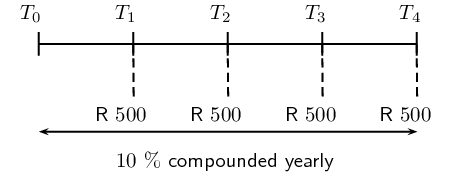Gerald wants to buy a new guitar worth \(\text{R}\,\text{7
400}\) in a year's time. How much must he deposit at the
end of each month into his savings account, which earns
a interest rate of \(\text{9,5}\%\) p.a. compounded
monthly?
Write down the given information and the future value
formula:
\[F = \frac{x\left[(1 + i)^{n}-1\right]}{i}\]
To determine the monthly payment amount, we make \(x\) the
subject of the formula:
\[x = \frac{F \times i}{\left[(1 + i)^{n}-1\right]}\]
\begin{align*}
F &= \text{7 400} \\
i &= \frac{\text{0,095}}{12} \\
n &= 1 \times 12 = \text{12}
\end{align*}
Substitute the known values and calculate \(x\):
\begin{align*}
x &= \dfrac{\text{7 400} \times
\frac{\text{0,095}}{12}}{\left[(1 +
\frac{\text{0,095}}{12})^{12}-1\right]} \\
&= \text{R}\,\text{590,27}
\end{align*}
Write the final answer:
Gerald must deposit \(\text{R}\,\text{590,27}\) each month so
that he can afford his guitar.
Ruth decides to save for her retirement so she opens a
savings account and immediately deposits
\(\text{R}\,\text{450}\) into the account. Her savings
account earns \(\text{12}\%\) per annum compounded
monthly. She then deposits \(\text{R}\,\text{450}\) at
the end of each month for \(\text{35}\) years. What is
the value of her retirement savings at the end of the
\(\text{35}\) year period?
Write down the given information and the future value
formula:
\[F = \frac{x\left[(1 + i)^{n}-1\right]}{i}\]
\begin{align*}
x &= \text{450} \\
i &= \frac{\text{0,12}}{12} \\
n &= 1 + (35 \times 12) = \text{421}
\end{align*}
Substitute the known values and calculate \(F\):
\begin{align*}
F &= \frac{\text{450}\left[(1 +
\frac{\text{0,12}}{12})^{\text{421}}-1\right]}{
\frac{\text{0,12}}{12}} \\
&= \text{R}\,\text{2 923 321,08}
\end{align*}
Write the final answer:
Ruth will have saved \(\text{R}\,\text{2 923 321,08}\) for
her retirement.
Lerato plans to buy a car in five and a half years' time. She
has saved \(\text{R}\,\text{30 000}\) in a separate
investment account which earns \(\text{13}\%\) per annum
compound interest. If she doesn't want to spend more
than \(\text{R}\,\text{160 000}\) on a vehicle and her
savings account earns an interest rate of
\(\text{11}\%\) p.a. compounded monthly, how much must
she deposit into her savings account each month?
First calculate the accumulated amount for the
\(\text{R}\,\text{30 000}\) in Lerato's investment
account:
\[A = P(1 + i)^{n}\]
\begin{align*}
P &= \text{30 000} \\
i &= \text{0,13} \\
n &= \text{5,5}
\end{align*}
\begin{align*}
A &= \text{30 000}(1 + \text{0,13})^{\text{5,5}}\\
&= \text{R}\,\text{58 756,06}
\end{align*}
In five and a half years' time, Lerato needs to have saved
\(\text{R}\,\text{160 000} - \text{R}\,\text{58 756,06}
= \text{R}\,\text{101 243,94}\).
\[x = \frac{F \times i}{\left[(1 + i)^{n}-1\right]}\]
\begin{align*}
F &= \text{101 243,94} \\
i &= \frac{\text{0,11}}{12} \\
n &= \text{5,5} \times 12 = \text{66}
\end{align*}
Substitute the known values and calculate \(x\):
\begin{align*}
x &= \dfrac{\text{101 243,94} \times
\frac{\text{0,11}}{12}}{\left[(1 +
\frac{\text{0,11}}{12})^{66}-1\right]} \\
&= \text{R}\,\text{1 123,28}
\end{align*}
Write the final answer:
Lerato must deposit \(\text{R}\,\text{1 123,28}\) each month
into her savings account.

